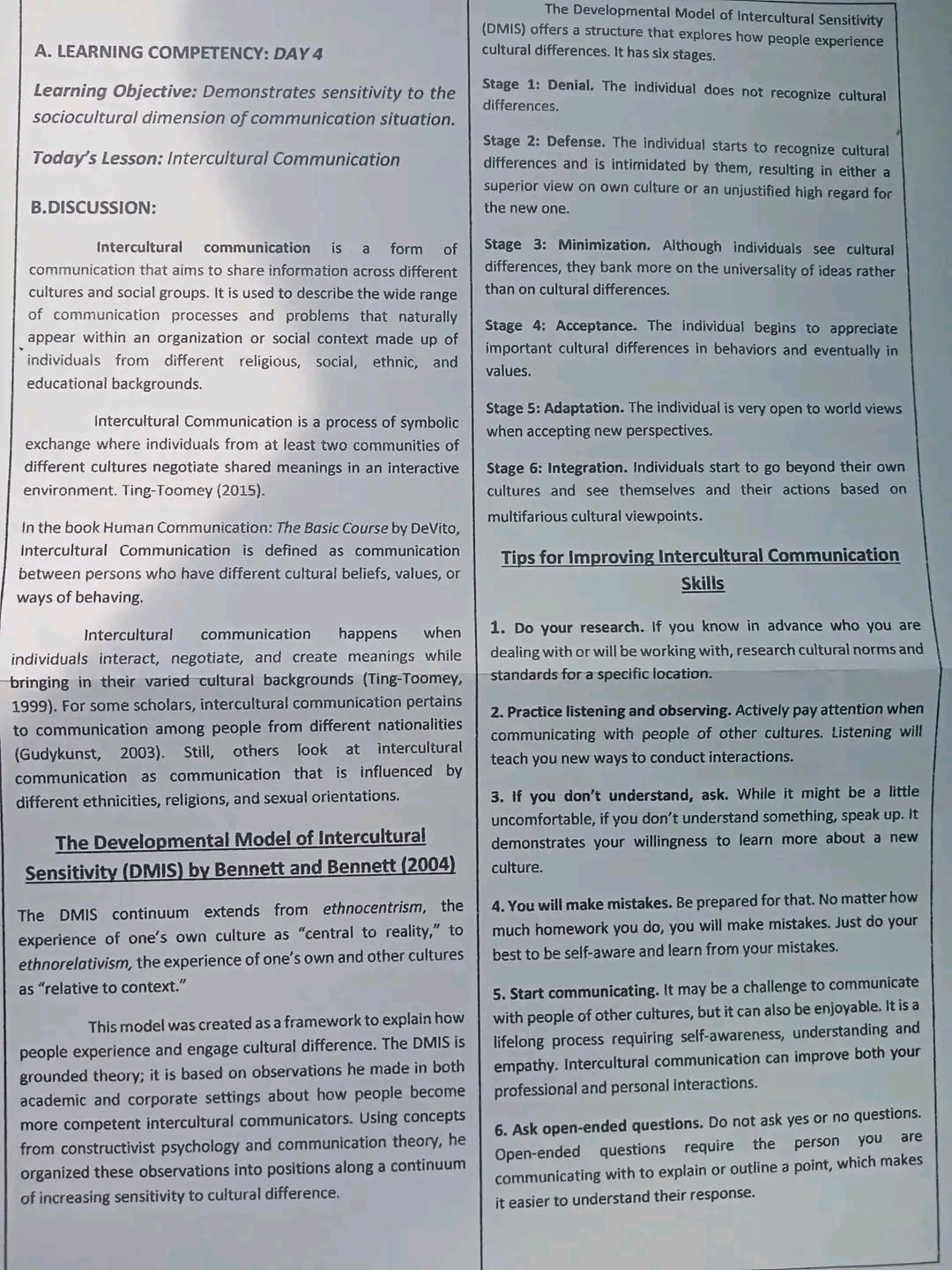Answered step by step
Verified Expert Solution
Question
1 Approved Answer
A. LEARNING COMPETENCY: DAY 4 Learning Objective: Demonstrates sensitivity to the sociocultural dimension of communication situation. Today's Lesson: Intercultural Communication B.DISCUSSION: Intercultural communication is


A. LEARNING COMPETENCY: DAY 4 Learning Objective: Demonstrates sensitivity to the sociocultural dimension of communication situation. Today's Lesson: Intercultural Communication B.DISCUSSION: Intercultural communication is form a of communication that aims to share information across different cultures and social groups. It is used to describe the wide range of communication processes and problems that naturally appear within an organization or social context made up of individuals from different religious, social, ethnic, and educational backgrounds. Intercultural Communication is a process of symbolic exchange where individuals from at least two communities of different cultures negotiate shared meanings in an interactive environment. Ting-Toomey (2015). In the book Human Communication: The Basic Course by DeVito, Intercultural Communication is defined as communication between persons who have different cultural beliefs, values, or ways of behaving. Intercultural communication happens when individuals interact, negotiate, and create meanings while bringing in their varied cultural backgrounds (Ting-Toomey, 1999). For some scholars, intercultural communication pertains to communication among people from different nationalities at intercultural (Gudykunst, 2003). Still, others look communication as communication that is influenced by different ethnicities, religions, and sexual orientations. The Developmental Model of Intercultural Sensitivity (DMIS) by Bennett and Bennett (2004) The DMIS continuum extends from ethnocentrism, the experience of one's own culture as "central to reality," to ethnorelativism, the experience of one's own and other cultures as "relative to context." This model was created as a framework to explain how people experience and engage cultural difference. The DMIS is grounded theory; it is based on observations he made in both academic and corporate settings about how people become more competent intercultural communicators. Using concepts from constructivist psychology and communication theory, he organized these observations into positions along a continuum of increasing sensitivity to cultural difference. The Developmental Model of Intercultural Sensitivity (DMIS) offers a structure that explores how people experience cultural differences. It has six stages. Stage 1: Denial. The individual does not recognize cultural differences. Stage 2: Defense. The individual starts to recognize cultural differences and is intimidated by them, resulting in either a superior view on own culture or an unjustified high regard for the new one. Stage 3: Minimization. Although individuals see cultural differences, they bank more on the universality of ideas rather than on cultural differences. Stage 4: Acceptance. The individual begins to appreciate important cultural differences in behaviors and eventually in values. Stage 5: Adaptation. The individual is very open to world views when accepting new perspectives. Stage 6: Integration. Individuals start to go beyond their own cultures and see themselves and their actions based on multifarious cultural viewpoints. Tips for Improving Intercultural Communication Skills 1. Do your research. If you know in advance who you are dealing with or will be working with, research cultural norms and standards for a specific location. 2. Practice listening and observing. Actively pay attention when communicating with people of other cultures. Listening will teach you new ways to conduct interactions. 3. If you don't understand, ask. While it might be a little uncomfortable, if you don't understand something, speak up. It demonstrates your willingness to learn more about a new culture. 4. You will make mistakes. Be prepared for that. No matter how much homework you do, you will make mistakes. Just do your best to be self-aware and learn from your mistakes. 5. Start communicating. It may be a challenge to communicate with people of other cultures, but it can also be enjoyable. It is a lifelong process requiring self-awareness, understanding and empathy. Intercultural communication can improve both your professional and personal interactions. are 6. Ask open-ended questions. Do not ask yes or no questions. Open-ended questions require the person you communicating with to explain or outline a point, which makes it easier to understand their response. Summarize all the new information that you have acquired from this worksheet about intercultural communication using the given graphic organizer. Supply the text space with the most essential concepts you have learned about the topic. INTERCULTURAL COMMUNICATION
Step by Step Solution
There are 3 Steps involved in it
Step: 1
I can help you summarize the key concepts about intercultural communication based on the provided in...
Get Instant Access to Expert-Tailored Solutions
See step-by-step solutions with expert insights and AI powered tools for academic success
Step: 2

Step: 3

Ace Your Homework with AI
Get the answers you need in no time with our AI-driven, step-by-step assistance
Get Started


